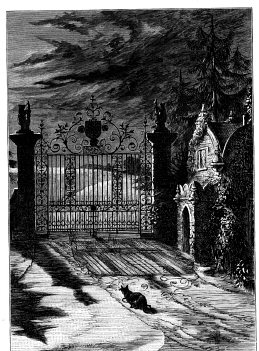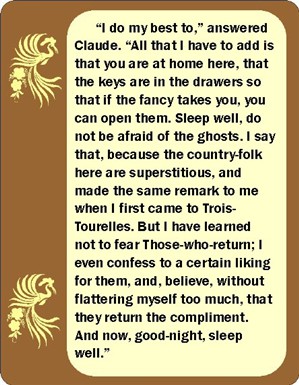

THOSE WHO RETURN
(L'ombre)
by Maurice Level
translated from the French by: Bérengère Drillien

MAURICE LEVEL (alias of Jeanne Mareteux-Level), a French conte cruel author of the era of the late 1800's-early 1900's, originally held employment as a medical doctor, before being inexorably drawn to the life of an author of conte cruel tales and as a playwright adapting the author's own work for the stage of the infamous Grand-Guignol Theatre of Paris (in performance between 1897-1962), otherwise known as the “Theatre of Horror.” Oscar Méténier had been the originator of this theatre company, which featured both comic burlesques and, most notably, short plays celebrated with the public for their violence, horror, and sometimes repugnant subject matter.
Of all the authors whose works pleasurably frightened & dismayed the Guignol's audience, the two most popular probably proved to be Level and André de Lorde (one of the more flamboyant Guignol authors, known for such plays as “La Dernière Torture” (1904), “Le Jardin des supplices” (1922), and a particularly manic and over-the-top adaption of Poe's “The System of Dr. Tarr and Professor Fether”). Level's own most popular works were based upon the author's previous short stories, with said stories being eventually collected and translated into English in both a British edition, Crises: A Volume of Tales of Mystery and Horror (1920), and an American edition, Tales of Mystery and Horror (1920). Unfortunately, despite some of the contents having appeared in short story anthologies and periodicals in both countries since publication, neither complete volume has seen republication and both remain somewhat rare and difficult to obtain from used book sellers.
The two Level tales that succeeded best at the Guignol were “Sous la lumière rouge” (translated as “In the Light of the Red Lamp”) of 1911 and “Le Baiser dans la nuit” (translated as “The Last Kiss”) of 1912. The last work has demonstrated the longest “legs” and life subsequent to its initial performance: a republication in 1913 in the French periodical Monde Illustré, revivals in 1922 & 1938, a one-act rewrite by British playwright Frederick Witney that appeared in his 1947 collection Grand Guignol, and, finally, even an unauthorized adaption borrowed for the American “EC” horror comic The Haunt of Fear in early 1952. The basic plot would be a simple revenge tale, but what a nasty twist at the end!
The fiction you're about to read, Those Who Return (original French title, L'ombre) represents an unusual work for Maurice Level. First, it was the only novel by the author, who tended towards favoring shorter creations. Second, it contains elements of the supernatural, atypical of Level's contes, where a brutal naturalism usually holds sway. Oddly, without my revealing too much of the novel's plot, I must note that it does conclude in a fashion very reminiscent of the Grand-Guignol, where, to quote Richard J. Hand and Michael Wilson in their excellent survey Grand-Guignol: The French Theatre of Horror (2002: The University of Exeter Press), “The horror can also be located around a bystander, who does not come to any physical harm but in the process of witnessing is taken to the ultimate horror.” In this sense, the unwitting witnesses of the novel's final nightmarish scene represent the true victims and not its actual participants.
As a last, important note, a book containing Guy de Maupassant's story “Apparition” plays a key role in the novel's plot and may or may not indicate the incursion of supernatural forces against the novel's protagonist, Claude de Marbois. For this reason, it would probably increase the reader's enjoyment and understanding of the novel, were he or she to spend a few minutes perusing this moody, eerie, and enjoyable tale beforehand.
CONTENTS:
Click bat to go back to the Library...
All text contents of these pages copyright © 2008 by R.J. Warren, all rights reserved.
All graphic contents of these pages copyright © 2008 by R.J. Warren, all rights reserved.